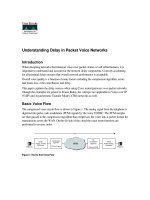Tài liệu Managing time in relational databases- P1 ppt
Bạn đang xem bản rút gọn của tài liệu. Xem và tải ngay bản đầy đủ của tài liệu tại đây (303.34 KB, 20 trang )
MANAGING TIME IN
RELATIONAL DATABASES
Companion Web site
Ancillary materials are available online at:
www.elsevierdirect.com/companions/9780123750419
MANAGING TIME IN
RELATIONAL DATABASES
How to Design, Update
and Query Temporal Data
TOM JOHNSTON
RANDALL WEIS
AMSTERDAM • BOSTON • HEIDELBERG • LONDON
NEW YORK • OXFORD • PARIS • SAN DIEGO
SAN FRANCISCO • SINGAPORE • SYDNEY • TOKYO
Morgan Kaufmann Publishers is an imprint of Elsevier
Morgan Kaufmann Publishers is an imprint of Elsevier.
30 Corporate Drive, Suite 400, Burlington, MA 01803, USA
This book is printed on acid-free paper.
#
2010 ELSEVIER INC. All rights reserved.
No part of this publication may be reproduced or transmitted in any form or by any means,
electronic or mechanical, including photocopying, recording, or any information storage and
retrieval system, without permission in writing from the publisher. Details on how to seek
permission, further information about the Publisher’s permissions policies and our arrangements
with organizations such as the Copyright Clearance Center and the Copyright Licensing Agency,
can be found at our website: www.elsevier.com/permissions.
This book and the individual contributions contained in it are protected under copyright by the
Publis
her (other than
as may be noted herein).
Notices
Knowledge and best practice in this field are constantly changing. As new research and experience
broaden our understanding, changes in research methods, professional practices, or medical
treatment may become necessary.
Practitioners and researchers must always rely on their own experience and knowledge in
evaluating and using any information, methods, compounds, or experiments described herein.
In using such information or methods they should be mindful of their own safety and the safety
of others, including parties for whom they have a professional responsibility.
To the fullest extent of the law, neither the Publisher nor the authors, contributors, or editors,
assume any liability for any injury and/or damage to persons or property as a matter of products
liability, negligence or otherwise, or from any use or operation of any methods, products,
instructions, or ideas contained in the material herein.
Library of Congress Cataloging-in-Publication Data
Application submitted
British Library Cataloguing-in-Publication Data
A catalogue record for this book is available from the British Library.
ISBN: 978-0-12-375041-9
For information on all Morgan Kaufmann publications,
visit our Web site at www.mkp.com or www
.elsevierdirect.com
Printe
d in the United States of America
10 11 12 13
14 5 4 3 2 1
ABOUT THE AUTHORS
Tom Johnston
Tom Johnston is an independent consultant specializing in the
design and management of data at the enterprise level. He has a
doctorate in Philosophy, with an academic concentration in
ontology, logic and semantics. He has spent his entire working
career in business IT, in such roles as programmer, systems pro-
grammer, analyst, systems designer, data modeler and enterprise
data architect. He has designed and implemented systems in over
a dozen industries, including healthcare, telecommunications,
banking, manufacturing, transportation and retailing. His current
research interests are (i) the management of bi-temporal data
with today’s DBMS technology; (ii) overcoming this newest gener-
ation of information stovepipes—for example, in medical records
and national security databases—by more cleanly separating the
semantics of data from the syntax of its representation; and (iii)
providing additional semantics for the relational model of data
by supplementing its first-order predicate logic statements with
modalities such as time and person.
Randall J. Weis
Randall J Weis, founder and CEO of InBase, Inc., has more
than 24 years of experience in IT, specializing in enterprise data
architecture, including the logical and physical modeling of very
large database (VLDB) systems in the financial, insurance and
health care industries.
He has been implementing systems with stringent temporal
and performance requirements for over 15 years. The bi-temporal
pattern he developed for modeling history, retro activity and
future dating was used for the implementation of IBM’s Insurance
Application Architecture (IAA) model. This pattern allows the
multidimensional temporal view of data as of any given effective
and assertion points in time.
InBase, Inc. has developed software used by many of the
nation’s largest companies, and is known for creating the first
popular mainframe spellchecker, Lingo, early in Randy’s career.
Weis has been a senior consultant at InBase and other companies,
such as PricewaterhouseCoopers LLP, Solving IT International
vii
Inc., Visual Highway and Beyond If Informatics. Randy has been a
presenter at various user groups, including Guide, Share, Midwest
Database Users Group and Camp IT Expo, and has developed
computer courses used in colleges and corporate training
programs.
Randy had been married to his wife Marina for over 30 years,
and has 3 children, Matt, Michelle and Nicolle. He plays guitar
and sings; he enjoys running, and has run several marathons.
He also creates web sites and produces commercial videos.
He may be reached via email at
viii
ABOUT THE AUTHORS
PREFACE
Over time, things change—things like customers, products,
accounts, and so forth. But most of the data we keep about
things describes what they are like currently, not what they used
to be like. When things change, we update the data that
describes them so that the description remains current. But all
these things have a history, and many of them have a future as
well, and often data about their past or about their future is also
important.
It is usually possible to restore and then to retrieve historical
data, given enough time and effort. But businesses are finding it
increasingly important to access historical data, as well as data
about the future, without those associated delays and costs.
More and more, business value attaches to the ability to directly
and immediately access non-current data as easily as current
data, and to do so with equivalent response times.
Conventional tables contain data describing what things are
currently like. But to provide comparable access to data describ-
ing what things used to be like, and to what they may be like in
the future, we believe it is necessary to combine data about the
past, the present and the future in the same tables. Tables which
do this, which contain data about what the objects they repre-
sent used to be like and also data about what they may be like
later on, together with data about what those objects are like now,
are versioned tables.
Versioned tables are one of two kinds of uni-temporal tables.
In this book, we will show how the use of versioned tables lowers
the cost and increases the value of temporal data, data that
describes what things used to be like as well as what they are like
now, and sometimes what they will be like as well. Costs, as
we will see, are lowered by simplifying the design, maintenance
and querying of temporal data. Value, as we will see, is increased
by providing faster and more accurate answers to queries that
access temporal data.
Another important thing about data is that, from time to
time, we occasionally get it wrong. We might record the wrong
data about a particular customer’s status, indicating, for example,
that a VIP customer is really a deadbeat. If we do, then as soon
as we find out about the mistake, we will hasten to fix it by
updating the customer’s record with the correct data.
ix









